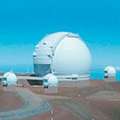 美國太空總署(NASA)計畫斥資5,000萬美元在夏威夷設置凱克(W.M. Keck)天文觀測站的計畫,預計增設6座天文望遠鏡,不過此計畫最近遇到司法障礙。望遠鏡設置預定地位於保育區──太平洋最高峰的茂納凱亞(Mauna Kea)峰頂,原本已取得州政府設立許可,但近日遭到州立法院撤銷,觀測站擴建計劃增添變數。
美國太空總署(NASA)計畫斥資5,000萬美元在夏威夷設置凱克(W.M. Keck)天文觀測站的計畫,預計增設6座天文望遠鏡,不過此計畫最近遇到司法障礙。望遠鏡設置預定地位於保育區──太平洋最高峰的茂納凱亞(Mauna Kea)峰頂,原本已取得州政府設立許可,但近日遭到州立法院撤銷,觀測站擴建計劃增添變數。
茂納凱亞峰是脆弱又獨特的高山生態系統,並且是整個夏威夷島的主要水源,因此被列為生態保區。在該保護區所進行的計畫唯有能夠在不損害公共資源的方法執行情形下,才能獲得許可。
目前在茂納凱亞峰已有13座望遠鏡和相關設備,NASA預計在世界上最大的兩座紅外線光學週邊,再興建4到6座小型望遠鏡,同時也是世界上最大的兩座紅外線光學凱克望遠鏡周圍;NASA計畫的最終目的,是要探討兩個基本問題的答案──「我們從哪裡來?」「宇宙中只有我們嗎?」
為了反對NASA計畫,美國保育團體山巒協會(Sierra Club)夏威夷洛亞分會提起訴訟,控訴夏威夷土地與自然資源局2003-2004年間辦過一連串異議公聽會後,仍然在2004年11月核准該計畫。在訴願聽證會上,夏威夷原住民、宗教人士和文化專家都出席作證,均反對NASA計畫。
訴願團體認為,夏威夷大學天文研究中心(UHIFA)所提出的管理計畫,僅涵蓋望遠鏡部分,並沒有把整個茂納凱亞峰的環境考慮進去。
訴願團體聲稱,如果沒有完善的管理計畫,夏威夷人民的權利和資源都會面臨風險。他們認為目前的管理計畫對於危險廢棄物與廢水污染、夏威夷原住民維護傳統習俗的權利和資源,幾乎沒有提供任何保護。
土地與自然資源局和夏威夷大學天文研究中心聲稱,他們所提出的管理計畫已符合土地與自然資源局的規定。不過州立法院法官賀拉(Judge Hara)持不同見解,他認為:「需要獲得保育、保護和保存的資源,是整個茂納凱亞山峰,而非只有該計畫所涵蓋的區域。」因此,他裁定,先前核發許可之決策,無助於推動保護區長遠的永續發展,也違反了州政府規範保護區的法律。
A Hawaii state court has reversed a conservation district use permit granted by a state agency that would have allowed the construction of up to six more telescopes on the summit of Mauna Kea, the tallest mountain in the Pacific. The ruling puts a roadblock in the path of NASA's $50 million outrigger telescope project planned for the W.M. Keck observatory.
Judge Hara decided that administrative rules governing astronomy facilities require a "comprehensive management plan" for the Mauna Kea summit, which is a conservation district.
The Mauna Kea summit is a conservation district because it is a fragile and unique alpine ecosystem that serves as a major source of water for the entire island of Hawaii. Development in conservation districts is permitted only if it can be done in a way that does not degrade the public resource.
There already are 13 telescopes and support facilities at the Mauna Kea summit.
An array of four to six small telescopes, called outriggers, are planned to surround the existing twin Keck telescopes, the world's largest optical and infrared telescopes. The Outrigger Telescopes Project is a key element in NASA's Origins program, which seeks answers to two basic questions - "Where do we come from?" and "Are we alone?"
Two Hawaiian organizations, the Sierra Club Hawaii Chapter Moku Loa Group, and an individual, appealed the BLNR permit for the Outrigger Project in November 2004 after contested case hearings that lasted through 2003-2004. During the hearings on appeal, Native Hawaiian lineal and cultural descendants, religious practitioners, and cultural experts testified in the appellants' favor.
Appellants argued the management plan offered by the UH Institute for Astronomy (UHIFA) covered only the Outrigger project, was not comprehensive, and did not cover the entire summit.
The appellants claimed without a comprehensive management plan, the rights and resources of the people of Hawaii were at risk. They argued that the management plan offered little protection against hazardous and sewage waste contamination or the protection of Native Hawaiian traditional and customary rights and resources.
Both the BLNR and UHIFA argued that the single project management plan they wrote was sufficient to meet BLNR requirements.
Judge Hara held that, "The resource that needs to be conserved, protected and preserved is the summit area of Mauna Kea, not just the area of the project."
He ruled that granting permits on a project by project basis did not promote long term sustainability of the protected resource as required by state law governing conservation districts.



